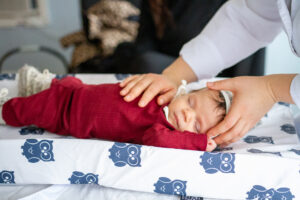You’ve probably seen it many times. A baby presents the following symptoms: gas, colic, clicking while feeding, poor weight gain, fussiness, or difficulty staying on the breast. You know that these signs point to tongue-tie or ankyloglossia. If a tie is diagnosed, the next step is a revision, where you release the frenulum or the band of tissue that attaches the tongue to the floor of the mouth.
But what happens after the tongue-tie revision? Ideally, it resolves the issue, and the baby can feed without further problems. However, that’s not always the case.
Many times, the tongue-tie revision is just the beginning.
In this article, we will discuss the missing piece in tongue-tie revision aftercare, why it is essential and how you can help the babies you see have a successful breastfeeding journey.
The Importance of Tongue-Tie Revision Aftercare
Tongue-tie revision is a simple procedure that involves cutting the frenulum or the band of tissue that attaches the tongue to the floor of the mouth.
However, just because it is a simple procedure does not mean it should be taken lightly. There are a few things that increase the odds that your revision will be successful.
As you know, the frenulum can reattach. Recurrence can happen for many reasons, which is incredibly frustrating for parents. They have already gone through the tongue-tie revision and thought that would be it.
With recurrence, their baby returns to having the same issues.
Having their baby undergo the tongue-tie revision again is heartbreaking and overwhelming for many parents.
Not only does recurrence cause emotional stress for parents, but it can also cause physical pain for the baby, mouth aversions and sometimes breast refusal. A tongue-tie revision may be a simple procedure, but it is still surgery. The baby’s mouth will be sore and tender after the surgery.
Obviously, your goal is to have the procedure be successful the first time. The result is happy babies, happy parents and a thriving practise built on satisfied patients.
So what can you do to improve the efficacy of your tongue-tie revisions?
The missing piece is craniosacral therapy.
What is craniosacral therapy?
Craniosacral therapy (CST) is a practice that uses gentle pressure and movement to release tension in the muscles, and connective tissue that can be found throughout the whole body. Developed by osteopathic physician John E. Upledger in the 1970s, CST is based on the idea that the stimulation of the flow of cerebrospinal fluid (CSF) throughout the body allows for the relaxation of muscles and tissues.
Craniosacral therapy is done by trained therapists, such as our team at MyBaby CST, who use light touch to release tension in the fascia of the body that surrounds organs, bones, and muscles. It is a very gentle technique; most parents report their babies feeling relaxed during and after the session. Once the therapist releases the fascial tissues, the body moves more freely, and can also heal easier and more symmetrically.
Let’s discuss why craniosacral therapy can help your patients after their tongue-tie revision.
How Does Craniosacral Therapy Help After A Tongue Tie Revision?
Craniosacral therapy aims to release any restrictions in the movement of the fascia, muscles, and connective tissue in the body. While a tongue tie revision may focus on the tongue, there may be an underlying issue elsewhere in the body like the upper neck, head, or even belly button.
The body is a whole, not separate parts connected by joints. In fact, tissues in the body that go down to the toes are connected by fascia to the tongue. This fascia could be the cause of a reattachment. You see, if you do not find and resolve restrictive tissues at the knees, let’s say, that area will continue pulling the tongue down and increase the chances of reattachment post frenectomy.
Alternatively, babies can develop torticollis in utero, which is a bending and torsion of the spine to one side. If this twisting to one side is not addressed, this may produce a re-attachment on one side and not the other. When the tongue re-attaches asymmetrically, that can lead to a head tilt.
Applying gentle treatment and doing bodywork, such as CST, at these potential points of origin can positively resolve the issue in a much more comprehensive and complete way.
Practitioners recommend exercises before or after surgery when tongue tie releases are performed on older children or adults. However, that is a challenge for parents of newborns since they are already sleep deprived and stressed due to having a new baby! This is where craniosacral therapy comes in and works to increase the odds that the surgery is successful.
Let’s look at one example. Baby Jane’s (name changed) parents came to us because their dentist recommended body work following her tongue tie revision. Not only were her parents able to avoid reattachment, but CST also improved her tongue function, which allowed for better breastfeeding.
We often see this with CST. While parents will bring their baby in to address one issue, the ripple effect of the therapy often addresses other issues as well. That is why CST is an essential piece of the puzzle for tongue tie revision aftercare.
MyBaby CST and Your Practice
If you are a practitioner who performs tongue tie revisions, I encourage you to consider adding CST to your recommended aftercare services. This missing piece makes all the difference for the babies in your care.
Our team at MyBaby CST is passionate about helping babies and families reach their full potential. We have helped hundreds of families better heal from tongue tie revisions and face other feeding difficulties. We would be happy to answer any questions about how craniosacral therapy can help your patients.






